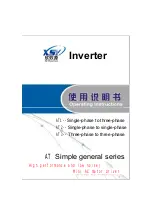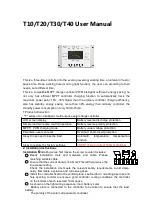
75
4. Parameter description
Parameter
Example 5: In this example, a 1V negative bias is used. In noisy environments it is advantageous to
use negative bias to provide a noise margin (1V in this example).
10V
1V
0V
54Hz
60Hz
0Hz
6Hz
Negative
Bias 6Hz
P.139 =
1V
10V
* 100%
Max output
frequency
Parameter setting:
P.38 = 60Hz
Max operation frequency
P.139 =10%
Bias adjustment
P.140 = 100% Gain adjustment
P.141 = 1 Negative Bias, can not reverse
P.73 = 1 Voltage signal selection
Example 6: In this example, a negative bias is used to provide a noise margin. Also a potentiometer
frequency gain is used to allow the Maximum Output Frequency to be reached.
10V
1V
0V
60Hz
0Hz
Bias
adjustment
6.6Hz
P.140 =
10V
* 100% = 111.1%
9V
Max output
frequency
Negative
Bias 6.6Hz
Parameter setting:
P.38 = 60Hz
Max operation frequency
P.139 =10%
Bias adjustment
P.140 = 111% Gain adjustment
P.141 = 1 Negative Bias, can not reverse
P.73 = 1 Voltage signal selection
Example 7: In this example, the input is programmed to run a motor in both forward and reverse
direction. The motor will be idle when the potentiometer position is at mid-point of its
scale. Using the settings in this example disables the external FWD and REV controls.
10V
5V
0V
30Hz
60Hz
0Hz
60Hz
30Hz
Max output frequency
Parameter setting:
P.38 = 60Hz
Max operation frequency
P.139 =50%
Bias adjustment
P.140 = 200% Gain adjustment
P.141 = 11 Negative Bias, can reverse
P.73 = 1 Voltage signal selection
Forward direction
Reverse direction
















































